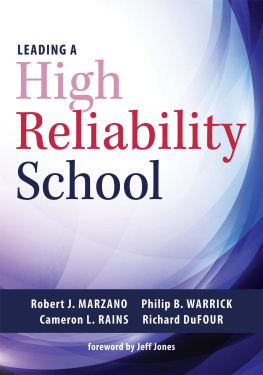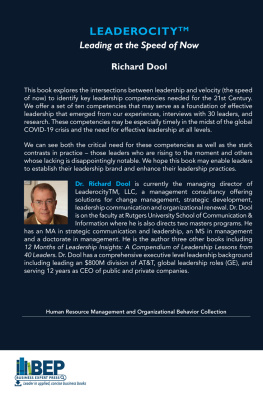STOP
LEADING LIKE ITS
Yesterday!
Key Concepts for Shaping Todays School Culture
Casey Reason

Copyright 2015 by Solution Tree Press
All rights reserved, including the right of reproduction of this book in whole or in part in any form.
555 North Morton Street
Bloomington, IN 47404
800.733.6786 (toll free) / 812.336.7700
FAX: 812.336.7790
email: info@solution-tree.com
solution-tree.com
Printed in the United States of America
18 17 16 15 14 1 2 3 4 5

Library of Congress Cataloging-in-Publication Data
Reason, Casey S.
Stop leading like its yesterday! : key concepts for shaping todays school culture / Casey Reason.
pages cm
Includes bibliographical references and index.
ISBN 978-1-936763-19-1 (perfect bound) 1. Educational leadership. 2. School management and organization. I. Title.
LB2806.R34 2014
371.2--dc23
2014023924
Solution Tree
Jeffrey C. Jones, CEO
Edmund M. Ackerman, President
Solution Tree Press
President: Douglas M. Rife
Editorial Director: Lesley Bolton
Managing Production Editor: Caroline Weiss
Production Editor: Rachel Rosolina
Proofreader: Elisabeth Abrams
Cover and Text Designer: Rian Anderson
Text Compositor: Rachel Smith
For Ron, Doug, and Scottfriends who motivate,
inspire, and keep me from thinking like its yesterday.
Acknowledgments
Id like to thank the entire Solution Tree team for their support throughout this process. Your patience and thoughtfulness make the process a joy. I would especially like to thank CEO Jeff Jones for personally reaching out and encouraging me to make this book a reality. His dedication to people is extraordinary. My friend and editor Stephanie Grant continues to be a model of efficiency and effectiveness. Thank you for helping me bring my words to life. Thank you also to Angie, Brenna, and Karen, other members of my corporate team who allow me to serve others in so many ways.
Solution Tree Press would like to thank the following reviewers:
JoAnne Greer
Principal
Jenifer Junior High School
Lewiston, Idaho
Robbie Hooker
Principal
Clarke Central High School
Athens, Georgia
Bryan Starr
Principal
Scio High School
Scio, Oregon
Gregory Zenion
Principal
Chariho Middle School
Wood River Junction, Rhode Island
Table of Contents
About the Author

Casey Reason, PhD, is an expert in collaboration, innovation, overcoming resistance to change, and next-level leadership. He has worked with a variety of clients, including some of the top Fortune 100 companies in the world.
Reason is the former principal of Whitmer High School, one of the largest urban buildings in Ohio. At the end of his five-year tenure as principal, his school was honored by the state of Ohio with a special commendation for dramatic improvement in student achievement. A strong promoter of teacher leadership and an early innovator in professional learning communities, he later applied these same principles of collaboration and innovation at the district level as an assistant superintendent for instructional services with Northville Schools.
His easily applied approaches are founded on the emerging body of research in brain science and adult learning theory. Reason has worked with leaders throughout the United States, Switzerland, India, and New Zealand. He earned a prestigious 2010 Blackboard International Exemplary Course Program Award for a doctorate-level leadership course he designed.
He earned a PhD from Bowling Green State University. To learn more about Caseys work, visit www.caseyreason.com or follow @caseyreason on Twitter.
To book Casey Reason for professional development, contact pd@solution-tree.com.
INTRODUCTION
Today Is Not YesterdayGet Ready!
This book is devoted to helping you, the principal, challenge the absurd assumption that you can lead today as if it was yesterday. Simply put, you cant. Even if you were a good leader yesterday, the game has changed significantly, and you have to change with it. I have been directly involved in designing award-winning principal and teacher leadership training since 2001, and I can safely say that much of what we designed just a few years ago either no longer applies or the application has changed dramatically. This book will help you recognize how leadership is changing in response to a very different set of challenges in schools; it will arm you with specific key concepts and requisite implementation strategies that will provide the tools you need to successfully leadtoday and tomorrow.
In the pages that follow, Ill be sharing a new leadership model thats called Leading for Excellence and Fulfillment (LEAF). This model is designed for school leaders with the unique challenges of today in mind. Furthermore, the model takes advantage of the latest research on human performance, learning theory, and psychology. The ideas presented in this book arent just well-intended, homespun pieces of advice. They represent the synthesis of a generous amount of research on learning and human performance that will help you shape your leadership behaviors in the most productive way possible.
Whats rather surprising about this collection of key concepts and strategies is that, in many cases, it represents a distinct departure from much of the common wisdom about leadership from the past. Youll learn in the following pages that much of what you were taught about leadership was designed for a world of work that doesnt exist anymore. To illustrate this chasm between yesterday and today, I want to begin by taking a brief look back.
The Industrial Revolution
Our traditional notions of leadership and organizational development in schools emerged due to significant historic and economic forces. In the late 1800s and early 1900s, when the United States was going through the Industrial Revolution, cities were growing, and work environments were defined very differently than they are today (Eisner, 2002; Gray, 1993). Frederick Taylor, a mechanical engineer, developed the managerial style of the Industrial Revolution; it was known as scientific management or Taylorism (Taylor, 1911). As you read the following list of scientific managements work expectations and conditions, think about how different the world of work is now from the systems envisioned when these models were developed.
- Employers valued compliance and consistency over high performance and differentiation.
- The work being done was mostly boring.
- The workers were poorly educated and had very low skill levels.
- Meeting expectations meant following very specific work parameters.
- There was a great need for workers to respect authority and comply explicitly with everything they were told to do.
- Workers had to endure high levels of boredom.
- Everything was measured by time. Quality was assumed within the confines of the routine, and time was used to maximize efficiency (Eisner, 2002).













